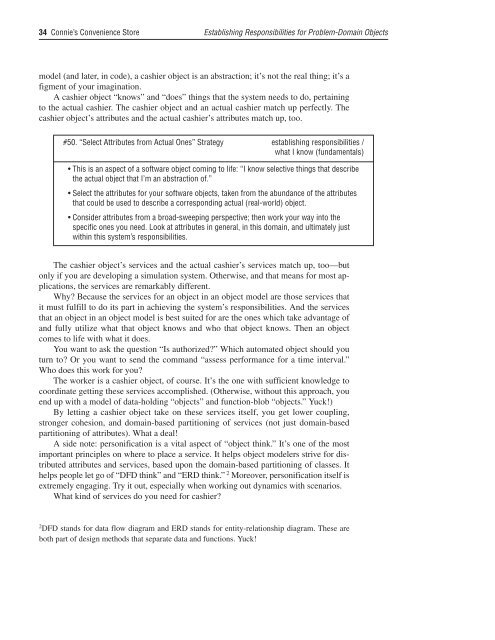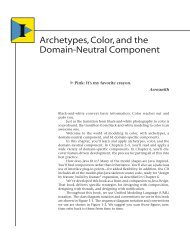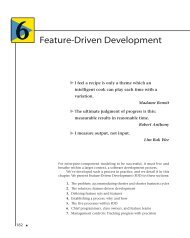Connie's Convenience Store - About Peter Coad
Connie's Convenience Store - About Peter Coad
Connie's Convenience Store - About Peter Coad
You also want an ePaper? Increase the reach of your titles
YUMPU automatically turns print PDFs into web optimized ePapers that Google loves.
34 Connie’s <strong>Convenience</strong> <strong>Store</strong> Establishing Responsibilities for Problem-Domain Objects<br />
model (and later, in code), a cashier object is an abstraction; it’s not the real thing; it’s a<br />
figment of your imagination.<br />
A cashier object “knows” and “does” things that the system needs to do, pertaining<br />
to the actual cashier. The cashier object and an actual cashier match up perfectly. The<br />
cashier object’s attributes and the actual cashier’s attributes match up, too.<br />
#50. “Select Attributes from Actual Ones” Strategy establishing responsibilities /<br />
what I know (fundamentals)<br />
• This is an aspect of a software object coming to life: “I know selective things that describe<br />
the actual object that I’m an abstraction of.”<br />
• Select the attributes for your software objects, taken from the abundance of the attributes<br />
that could be used to describe a corresponding actual (real-world) object.<br />
• Consider attributes from a broad-sweeping perspective; then work your way into the<br />
specific ones you need. Look at attributes in general, in this domain, and ultimately just<br />
within this system’s responsibilities.<br />
The cashier object’s services and the actual cashier’s services match up, too—but<br />
only if you are developing a simulation system. Otherwise, and that means for most applications,<br />
the services are remarkably different.<br />
Why? Because the services for an object in an object model are those services that<br />
it must fulfill to do its part in achieving the system’s responsibilities. And the services<br />
that an object in an object model is best suited for are the ones which take advantage of<br />
and fully utilize what that object knows and who that object knows. Then an object<br />
comes to life with what it does.<br />
You want to ask the question “Is authorized?” Which automated object should you<br />
turn to? Or you want to send the command “assess performance for a time interval.”<br />
Who does this work for you?<br />
The worker is a cashier object, of course. It’s the one with sufficient knowledge to<br />
coordinate getting these services accomplished. (Otherwise, without this approach, you<br />
end up with a model of data-holding “objects” and function-blob “objects.” Yuck!)<br />
By letting a cashier object take on these services itself, you get lower coupling,<br />
stronger cohesion, and domain-based partitioning of services (not just domain-based<br />
partitioning of attributes). What a deal!<br />
A side note: personification is a vital aspect of “object think.” It’s one of the most<br />
important principles on where to place a service. It helps object modelers strive for distributed<br />
attributes and services, based upon the domain-based partitioning of classes. It<br />
helps people let go of “DFD think” and “ERD think.” 2 Moreover, personification itself is<br />
extremely engaging. Try it out, especially when working out dynamics with scenarios.<br />
What kind of services do you need for cashier?<br />
2 DFD stands for data flow diagram and ERD stands for entity-relationship diagram. These are<br />
both part of design methods that separate data and functions. Yuck!




